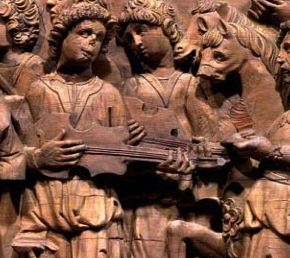Two vihuelists, from woodcarving “the Triumphs of Caesar,” from the palace of Pedro Fajardo y Chacón, first Marqués de Vélez Blanco, Vélez Blanco (Almería).
(1510-1515) - Paris, Musée des Arts Décoratifs.
instrument: vihuela de mano | century: 16cent/1/early | catalogue nº: 16-146

Artwork
Creator anon
Medium Artwork: Sculpture
Location
City Vélez Blanco | Region Andalucia | Old kingdom Castile
Characteristics
| Body Corners | Strings 3 strings | Neck Short | Pegbox Sickle |
| Bridge Fixed | Frets No | Back Not visible | Pegs |
| Technique Plucked fingers thumb in |
Commentary
ARTWORK
This pine carving originally from the palace of Pedro Fajardo y Chacón, first Marqués de Vélez Blanco, Vélez Blanco (Almería). is based on the print by Jacopo da Strasbourg of 1503. Current location: Musée des Arts Décoratifs, Paris. Carlos González drew attention to the carving after seeing it in Paris at the Musée des Arts Decoratifs in 1992. Later it was exhbited in the Museum in 1999, reported by F. Getreau (getreau2004, 48-49). It was reprinted on Used on the front cover of Hispanica Lyra no 10, and as the basis of the iconographical supplement in the same journal (gonzalez2009). These carvings adorned one of the principal rooms of the palace of Pedro Fajardo y Chacón, first Marqués de Vélez Blanco, and governor of the Kingdom of Murcia. This was the Salón del Triunfo, inspired by the Mantegna paintings and the prints of Jacopo da Strasbourg (see16-147).
INSTRUMENTS
Vihuelas with cornered waists, unusual body shape, and sickle shaped peg boxes, varied from the way they are depicted by Jacopo of Strsbourg, but obviously related. Despite close similarities with other instruments in Spanish artworks, these instruments cannot be taken as necessarily representative of Spanish instruments of the early 16th century.